AJKOER
Radically Dubious
    
Posts: 3026
Registered: 7-5-2011
Member Is Offline
Mood: No Mood
|
|
Galvanic Cell Assisted New Path to CuSO4
BACKGROUND ON PRIOR CuSO4 PREPARATIONS
One prior cited path on SM refers to a video which employs conc H2SO4 and Cu plus heating to produce CuSO4 and some SO2 (see http://www.sciencemadness.org/talk/viewthread.php?tid=81115#... ).
From another thread (see http://www.sciencemadness.org/talk/viewthread.php?tid=29122 ):
Also, from the same thread:
Quote: Originally posted by AJKOER  | Try this, add copper to aqueous ammonia plus H2O2. Over night you will witness the formation of Cu(NH3)4(OH)2, in an aqua blue solution.
Now, add MgSO4 hydrate (Epsom salt). Filter out the white precipitate of Mg(OH)2. You now have Cu(NH3)4SO4. The last step is to destroy the NH3 by
adding (speculation, I have not performed this part), say H2O2, and see if a massive amount of N2 is released with time (less than a day). Another
possible way to remove the ammonia complex, just boil the solution (outdoors). Last suggestion, isolate the dry salt tetrammine copper(II)sulfate and
heat. This would be the reverse reaction of its preparation, see http://www.google.com/url?sa=t&rct=j&q=tetra%20amine... There is some direct support for this method to remove ammonia based on a study
(see http://www.google.com/url?sa=t&rct=j&q=thermal%20dec... ) of the thermal decomposition of Copper tetra ammine dithionate where ammonia is
released in the early stage of decomposition.
If successful, the product is CuSO4 from simple available household chemicals.
……...
[Edited on 12-3-2014 by AJKOER] |
Or, one could also treat prepared copper carbonate (see http://www.sciencemadness.org/talk/viewthread.php?tid=1605#p... ) or freshly formed by copper hydroxide or oxide (see, for example, http://www.sciencemadness.org/talk/viewthread.php?tid=84047#... ) with NaHSO4 to produce CuSO4 employing more time and reagents.
Proposed New Path To CuSO4 Via Copper/Noble Metal/3% H2O2/NaHSO4/Chelate for Cuprous (Lemon juice or sea salt)
------------------------------------------------------------------------------------------------------------------------------------------------------
-----------------
I prepared copper sulfate following a protocol discussed in a prior tread ( essentially a galvanic cell activating hydrogen peroxide in the presence
of an acid source and the target metal for salt creation) which I believe will supplement the more standard chemical reactions occurring. The
procedure consistent of adding a one inch piece of copper tubing used in plumbing and a more noble metal (in this case, I employed a commemorative
thinly silver plated coin) to a solution of 120 ml of 3% hydrogen peroxide, and about 10 grams of sodium bisulfate and a small amount of a chelating
agent for cuprous (best would be lemon juice as it is consumed especially if external air is used to supplement the use of H2O2, while sea salt a good
chelator and electrolyte, used in my first run, may hinder the removal of Na2SO4 from the CuSO4 product). To remove the inception period, the aqueous
mix was heated in a microwave for 1 minute.
Some of the expected chemistry:
2 x [ NaHSO4 (aq) = Na+ (aq) + HSO4- (aq) ]
2 x [ HSO4- (aq) = H+ + SO4(2-) ]
Cu = Cu+ + e-
e- + nH2O --> e-(aq)
H2O2 = H+ + HO2-
H+ + e-(aq) = •H
•H + HO2- = •OH + OH-
Memo: Net of last 4 reactions:
H2O2 + e-(aq) --> •OH + OH- (one electron reduction of H2O2)
And as the source of e-(aq) is copper:
Cu = Cu+ + e-
The net of the above two reactions parallels a Fenton-type reaction in copper:
Cu + H2O2 = Cu(+) + •OH + OH-
----------------------------------------
A similar system of reactions based on:
Cu(+) --> Cu(++) + e-
......
Additional reactions due to radical formation includes:
•OH + HSO4- = •SO4- + H2O
e-(aq) + •SO4- -->SO4(2-)
e-(aq) + •OH --> OH-
where the reaction Cu(l) + •SO4- --> CuSO4 has an expected reaction rate of k > 10^8 , based on p. 15 reported reactions by •SO4-
acting on Fe(ll), Ce(lll), Cr(ll),.. at https://srd.nist.gov/NSRDS/NSRDS-NBS-65.pdf by Ross and Neta.
•H + •H = H2(g) (or H2S with possible small amounts of sulfide impurities present)
•H + SO4(2-) = OH- + SO3(2-) (a possible source of SO2 and perhaps more products)
Also, a decomposition reaction of H2O2 in presence of Cu2O/CuO (until attacked by H+):
2 H2O2 --Cu2O→ 2 H2O + O2
Approximate net reaction ignoring radical side reactions and copper oxide assisted self-decomposition of hydrogen peroxide:
Cu + 2 NaHSO4 (aq) + H2O2 → Cu(2+) + 2 Na+ + 2 SO4(2-) + 2 H2O
Note: per the above net reaction, Na2SO4 (as can be collected as a hydrate upon freezing absence the presence of chloride) molar concentration
should be approximately twice as much as the CuSO4.
Also, one can reduce the need for H2O2 by using an air pump as:
4 Cu+ + O2 (from air) + 2 H+ → 4 Cu2+ + 2 OH- (Source: See, for example, https://en.wikipedia.org/wiki/Copper(I)_chloride )
EXPERIMENTAL RESULTS USING SEA SALT
--------------------------------------------------------------
Following the mixing of ingredients and a brief period of 60 seconds in a microwave, a vigorous reaction occurred for 10 minutes, abated to some
extent and visually continued some hours (see attached pictures). At commencement, within minutes the starting copper metal, which had some
discoloration from prior experiments, became pristine clear. Also, an obvious blue coloration rapidly became evident consistent with the formation of
copper sulfate. At the end of the reaction (exhaustion I suspect of the H2O2 from several paths), a close examination of the solution also indicated
the formation of a tiny amount of a fine suspension (Na2SO4 salted out?). Upon opening the vessel there was evident of a small amount of an odorous
gas as well (possibly SO2 and/or H2S from sulfur impurities). After several hours, the reaction have ceased leaving copper metal (the anodic zone in
the galvanic cell) discolored. Following the addition of 70 ml more of 3% H2O2, in approximately 20 minutes the copper metal again became pristine
clear. After 6 hours, I decided not to reheat the solution (which remained warm to the touch), and terminated the experiment. Upon decanting the
aqueous CuSO4/Na2SO4 solution, it was frozen but unable to isolate the Na2SO4 hydrate likely due to the presence of NaCl.
[Edited on 4-10-2018 by AJKOER]
[Edited on 4-10-2018 by AJKOER]
|
|
|
symboom
International Hazard
    
Posts: 1143
Registered: 11-11-2010
Location: Wrongplanet
Member Is Offline
Mood: Doing science while it is still legal since 2010
|
|
Magnesium sulfate and oxalic acid forming insoluble magnesium oxalate decant off magnesium oxalate then add copper hydroxide to form copper sulfate I
don't see how this would not work
[Edited on 3-10-2018 by symboom]
|
|
|
AJKOER
Radically Dubious
    
Posts: 3026
Registered: 7-5-2011
Member Is Offline
Mood: No Mood
|
|
Starting picture before placing in microwave.
Second, is upon exiting of the microwave.
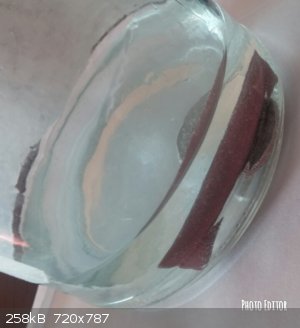
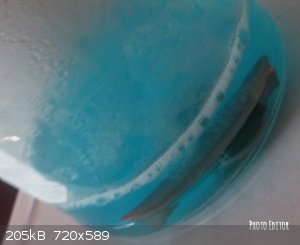
|
|
|
AJKOER
Radically Dubious
    
Posts: 3026
Registered: 7-5-2011
Member Is Offline
Mood: No Mood
|
|
Picture 40 minutes later.
Second picture is after adding more H2O2 towards end of experiment.
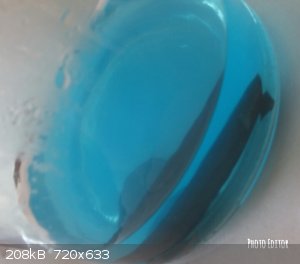
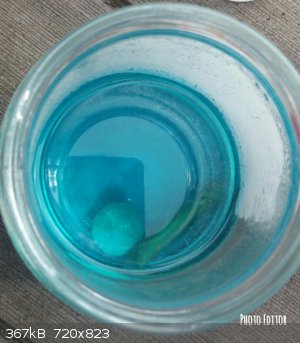
[Edited on 3-10-2018 by AJKOER]
|
|
|
AJKOER
Radically Dubious
    
Posts: 3026
Registered: 7-5-2011
Member Is Offline
Mood: No Mood
|
|
Quote: Originally posted by symboom  | Magnesium sulfate and oxalic acid forming insoluble magnesium oxalate decant off magnesium oxalate then add copper hydroxide to form copper sulfate I
don't see how this would not work
[Edited on 3-10-2018 by symboom] |
Thanks for the comment.
With respect to your comment, yes, quite possibly, but one has to have H2C2O4!
A word of warning, I did not store my toxic Oxalic acid in the refrigerator and over a hot summer, it decomposed on me!
Perhaps a quality issue, but my point is H2C2O4 may not be available and it is, in any event, more costly than NaHSO4.
|
|
|
AJKOER
Radically Dubious
    
Posts: 3026
Registered: 7-5-2011
Member Is Offline
Mood: No Mood
|
|
Re do with no NaCl but a few crystals of citric acid, H2O2, noble metal (a coin), NaHSO4 and application of an air pump to a piece of copper metal.
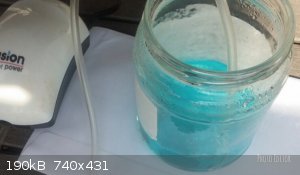
[Edited on 4-10-2018 by AJKOER]
|
|
|
Amos
International Hazard
    
Posts: 1406
Registered: 25-3-2014
Location: Yes
Member Is Offline
Mood: No
|
|
Quote: Originally posted by symboom  | Magnesium sulfate and oxalic acid forming insoluble magnesium oxalate decant off magnesium oxalate then add copper hydroxide to form copper sulfate I
don't see how this would not work
[Edited on 3-10-2018 by symboom] |
Now I've not tried this myself, but the reaction you describe between magnesium sulfate and oxalic acid is an equilibrium one; magnesium oxalate will
certainly dissolve to a degree in sulfuric acid to illustrate the reverse, and with sulfuric acid being the much stronger acid and dissociating fully
while oxalic will not, it should definitely lean towards re-forming magnesium sulfate. In theory at least, all you'll end up with by trying this is
dilute sulfuric acid highly contaminated with magnesium sulfate and oxalic acid.
|
|
|
symboom
International Hazard
    
Posts: 1143
Registered: 11-11-2010
Location: Wrongplanet
Member Is Offline
Mood: Doing science while it is still legal since 2010
|
|
It's always the simplest that never solver complex things it would be nice if it worked but I don't think the equivalent is not possible like the
quick and dirty nitric acid way with calcium nitrate and sulfuric acid.
citric acid, H2O2, noble metal (a coin) what is the coin made out of. Catalysts? copper citrate nice and simple.
[Edited on 5-10-2018 by symboom]
|
|
|
AJKOER
Radically Dubious
    
Posts: 3026
Registered: 7-5-2011
Member Is Offline
Mood: No Mood
|
|
Coins can be made of an alloy of copper and nickel and are designed to be corrosive resistance. In fact, if it isn't corrosive resistant upon testing
in circulation, it is likely redesign to be such. The goal is low cost and a low anodic index for an extended longevity.
Here is an example of an anodic index chart, see http://easternanode.nf.ca/anodic.php , note the alloys!
----
[Edited on 7-10-2018 by AJKOER]
|
|
|
symboom
International Hazard
    
Posts: 1143
Registered: 11-11-2010
Location: Wrongplanet
Member Is Offline
Mood: Doing science while it is still legal since 2010
|
|
Thanks copper nickel alloy is great to dissolve it leals the surface really shiny like a looks almost a white platnium
I especially like nickel more than copper. I dissoled a copper nickel coin with oxone and vinagar smelled strong but etched the surface nicely
|
|
|